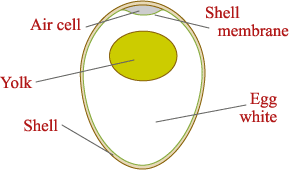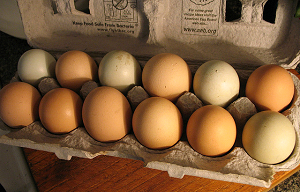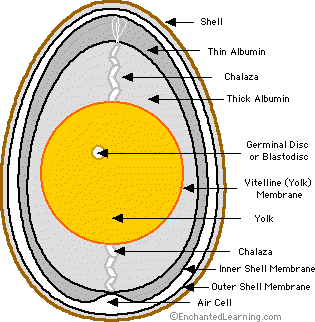
Grades and Sizes of Eggs - Definitions and Explanations
 What are the true, legal definitions of the various grades and
sizes of eggs that you see in the grocery store? Here are
their definitions!
What are the true, legal definitions of the various grades and
sizes of eggs that you see in the grocery store? Here are
their definitions!
Egg Grades
Egg Grading refers to both the exterior and interior of the egg. The eggs must be clean and free of major defects on the outside as well as the inside. ALL eggs are supposed to be candled to identify any internal defects. Refer to the USDA Egg Grades & Standards and the USDA Egg Grading Manual for complete instructions.The grade of a shell egg is determined by the size of the internal air-cell. As an egg ages, the liquid contents evaporate through its pores. The larger the air-cell is, the lower the grade of the egg. The outside appearance also factors into the grade of an egg. Eggs with moderate staining (but not adhering dirt) can be sold as grade "B." All other grades require a clean, unblemished shell appearance. Dirty eggs cannot be sold to consumers. The size of an egg is determined by its weight, in grams. A small egg must weight 40.16 grams or more, a jumbo egg must weigh 68.51 grams or more.
- Grade AA: These eggs have the thickest whites. The shell must be clean and unbroken. The air cell is limited to 1/8 inch depth at original and 3/16 inch at destination. The white must be clear and the yolk practically free of apparent defects. Considered a desirable quality in cooking because they do not spread easily, making them excellent for frying. The yolks are high, round and defect-free. U.S. grade AA egg shells are unbroken.
- Grade A - The shell must be clean and unbroken. The air cell is limited to 3/16 inch depth at original and 1/4 inch at destination. The white must be clear and the yolk practically free of apparent defects.Grade A eggs also have thick whites, just slightly thinner than Grade AA.
- Grade B - The shell must be clean and unbroken and may have unlimited slight stains (but not dirt clinging to shell). The air cell may not exceed 3/8 inch. The white must be clear and the yolk practically free of apparent defects. The white may be weak and watery and the yolk outline plainly visible the yolk may appear dark, enlarged and flattened. It may show other serious defects which do not render the egg inedible.Grade B eggs usually have thinner egg whites, making them best for cake mixes and omelets.
The nutritional value and taste of all the grades is the same.
Egg sizes
Eggs also are sold in a bewildering variety of sizes, which are based on their weight, not volume. The size markings on egg cartons tell the minimum net weight for a dozen eggs. The size names and weight per egg is given below:
| Size or Weight Class |
Min Weight per Egg |
Size or Weight Class |
Min Weight |
|
| Jumbo | 2.42 ounces | Medium | 1.67 ounces | |
| Extra Large | 2.17 ounces | Small | 1.42 ounces | |
| Large | 1.92 ounces | Peewee | no min |
NOTE: If you are unsure of the size of your eggs, label them the smallest size. For example, if you have at least medium sized eggs, label the carton as Medium. It is acceptable to have larger sized eggs in the carton.
(see USDA Shell Egg Grades & Standards)
Egg color
Whte, brown or other color, the color of an egg's shell does not affect its nutritional value, they're all the same. It's just a pigment in the shell, genetically determined. Leghorns lay white eggs. Ameraucanas lay blue eggs. Olive eggers lay olive green eggs. And Orpingtons lay brown eggs.
 Egg Carton Dates
Egg Carton Dates
Egg processors typically print dates commonly called "Code Dates" on cartons. sometimes they say "EXP," "Sell By," and "Best if Used Before". The use of code dates on USDA graded eggs is optional; it is NOT required by federal law. But, if they are used, certain rules must be followed:
- If an expiration date is used, it must be printed in month/day format and preceded by the appropriate prefix.
- Expiration dates can be no more than 30 days from the day the eggs were packed into the carton.
Another type of code dating used indicates the recommended maximum length of time that the consumer can expect eggs to maintain their quality when stored under ideal conditions. Terminology such as "Use by", "Use before", "Best before" indicates a period that the eggs should be consumed before overall quality diminishes. Code dating using these terms may not exceed 45 days including the day the eggs were packed into the carton.
More egg buying information
- Blood spots are caused by a rupture of one or more small blood vessels in the yolk at the time of ovulation. It does not indicate the egg is unsafe. You can remove it with the tip of a knife, if you want.
- A cloudy white (albumen) is a sign the egg is very fresh. A clear egg white is an indication the egg is aging.
- Pink or iridescent egg white (albumen) indicates spoilage due to Pseudomonas bacteria. Some of these microorganisms—which produce a greenish, fluorescent, water-soluble pigment—are harmful to humans.
- The color of yolk varies in shades of yellow depending upon the diet of the hen. If she eats plenty of yellow-orange plant pigments, such as from marigold petals and yellow corn, the yolk will be a darker yellow than if she eats a colorless diet such as white cornmeal. Artificial color additives are not permitted in eggs.
- A green ring on a hard-boiled yolk can be a result of overcooking, and is caused by sulfur and iron compounds in the egg reacting on the yolk's surface. The green color can also be caused by a high amount of iron in the cooking water. Scrambled eggs cooked at too high a temperature or held on a steam table too long can also develop a greenish cast. The green color is safe to consume.
More Background Information
There is much more to eggs that just the size and grade!
Egg candling
Candling is the process of using light to help determine the quality of an egg. A small producer may still inspect by holding them up to a candle. when an egg is rotated over the candling light, its yolk swings toward the shell. The distinctness of the yolk outline depends on how close to the shell the yolk moves, which is influenced by the thickness of the surrounding albumen. Thick albumen permits limited yolk movement while thin albumen permits greater movement; the less movement, the thicker the white and the higher the grade. Large scale farms use automated mass-scanning equipment to detect eggs with cracked shells and interior defects. During candling, eggs travel along a conveyor belt and pass over mechanical sensors integrated with computerized systems for segregation of defective eggs. Manual scanning techniques involve conveying the eggs over a light source where the defects become visible and the defective eggs are segregated. Hand candling-holding a shell egg directly in front of a light source—is done to spot check and determine accuracy in grading. Advanced technology, utilizing computerized integrated cameras and sound wave technology, is also being applied for the segregation of eggs.
Air cell sizes
If you've ever peeled a hard boiled egg, you've seen the air space at the wider end of the egg. That's an air cell.
- Grade AA eggs, the air cell may not exceed 1/8 inch in depth and is about the size of a dime.
- Grade A eggs may have air cells over 3/16 inch in depth.
- There is no limit on air cell size for Grade-B eggs.
Eggs take in air as they age, but the the size of the air cell varies even at the moment they are laid, so it does not necessarily relate to freshness.
More information?
An egg industry website has more detailed information on the
follow topics:
- Air Cell
- Blood Spots
- Breakout
- Buying
- Candling
- Egg Products
- Inspection Act
- Formation
- Haugh Unit
- Restricted Eggs
- Shell
- Yolk
